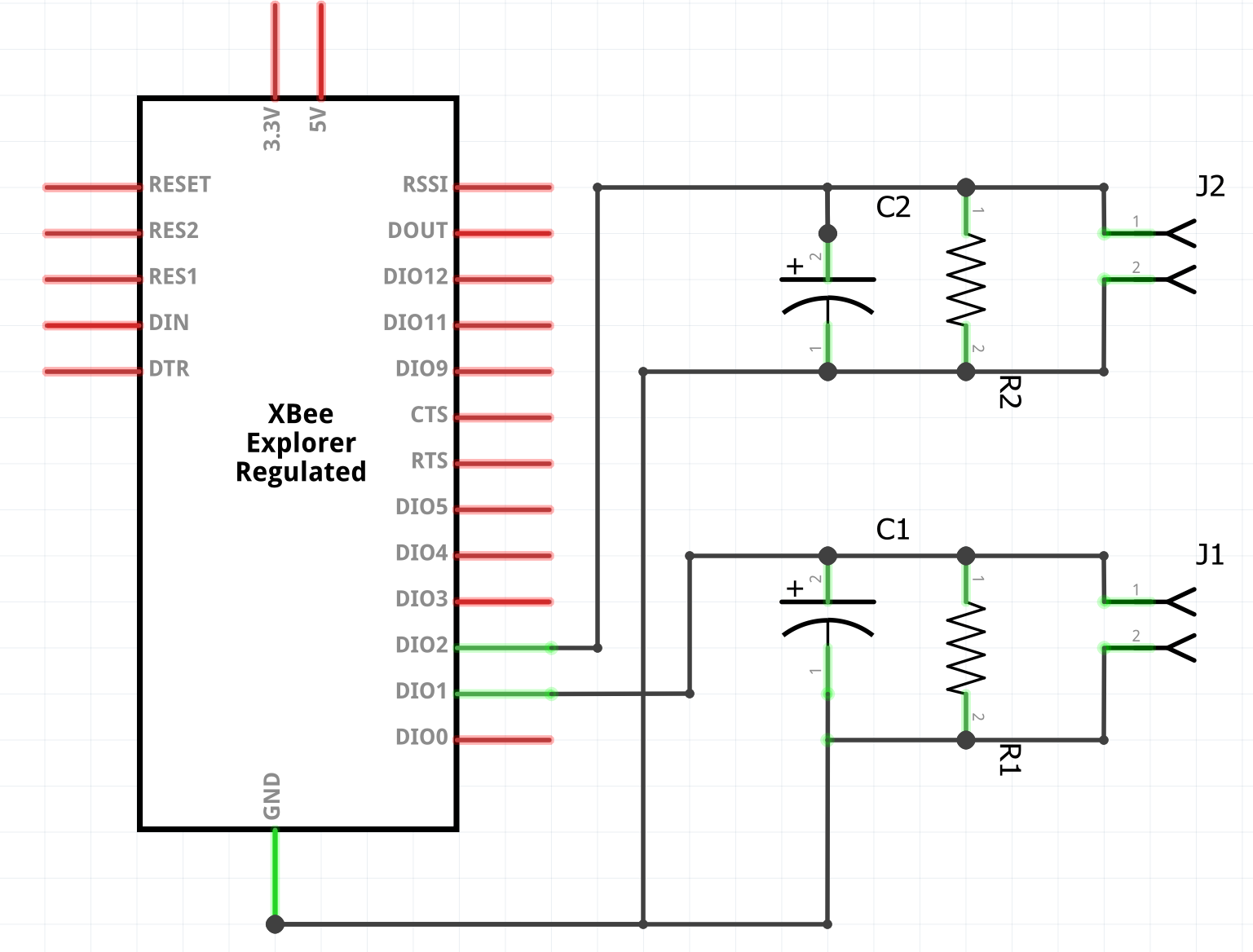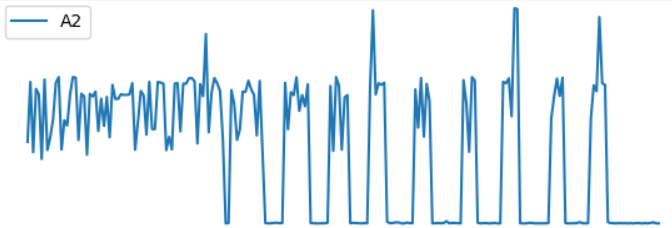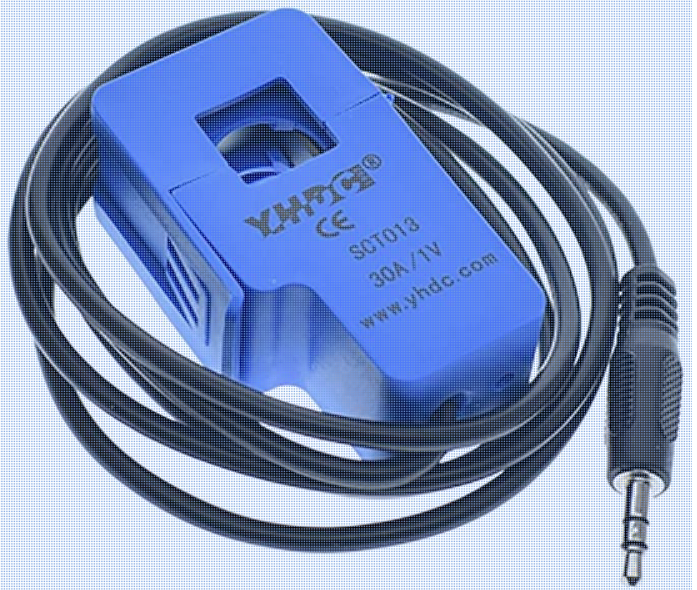Micropython code running on an XBee3 ZigBee RF module to read ADC values from CT sensors on washer and dryer A/C circuits.
In order to monitor the state of my home's laundry and receive notification when the washer and dryer are done, I use a current transducer (CT) sensor to detect each appliance's power state (i.e. whether CT voltage is detected via ADC pins).
The goal was to avoid any physical modifications to the high ampere/voltage circuits for these appliances. I also wanted to avoid using wireless switch plugs (e.g. Z-Wave) capable of sending energy usage telemetry, especially on the 240VAC (US) dryer outlet.
Installation requires turning off your home's main power, removing the circuit breaker panel cover, and clipping the CT sensors to each laundry circuit. Removing your panel is obviously dangerous and if you're not careful your family could find you as a smoking heap on the ground. So be careful.
The circuit to detect the power state uses a SCT-013-030 30A Non-invasive AC Current Sensor Split-Core Current Transformer, a load bearing resistor, and a capacitor. The XBee3 12-bit ADC pins read the low voltage (alternating current) across each resistor.
- R1 and R2: 33 ohms
- C1 and C2: 10 microfarads
- J1 and J2 connect to each CT.
The XBee3 sends the ADC readings to the ZigBee coordinator of the mesh network about every 10 seconds. The worker app xbee2mqtt uses custom coordinator code based on xbeesharp which translates XBee TX message frames to MQTT messages. The example MQTT laundry client mqtt-laundry subscribes and determines the state of the washer and dryer.
The state of the washer and dryer is based on a moving window of ADC values crossing a threshold. In my case the moving window is the average of the last 20 ADC readings and the threshold "on" state is a value of 20.
I do pre-aggregation of ADC samples on the XBee3 before transmitting. A remotely configurable global variable Sum_count defaults to 5. The idea is to 1) collect a reasonable signal from the clipped AC voltage before sending, 2) minimize the frequency of ZigBee packets and corresponding MQTT messages.
Once I gathered a weekend's worth of data from my family and myself doing our laundry, I was able to arrive at default aggregation count and threshold value settings.
Here are plots of the washer and dryer data points. For the washer, notice how the last part of the cycle -- the spin cycle -- quickly tapers to a slow tumble.
For the dryer, you can see the heating element turning on and off as the humidity sensor begins to detect less moisture.
Both the washer and dryer have periods where the current readings drop off; hence we need a window of time that spans those gaps.
I created a spreadsheet of the collected readings and did some comparisons, arriving at default values: Window size of 20 readings and a threshold value of 20 based on the average of those readings.
Here's what part of a spreadsheet shows for a 20-readings window when the washer (W) threshold is crossed (i.e. the washer is on) while the dryer (D) is off. The threshold values are AVG == 20 and P90 == 70:
| Secs | W | D | AVG(W) | AVG(D) | AVG(W) > 20 | AVG(D) > 20 | P90(W) | P90(D) | P90(D) > 70 | P90(D) > 70 | ||
|---|---|---|---|---|---|---|---|---|---|---|---|---|
| 0 | 3 | 5 | 9 | 5.45 | FALSE | FALSE | 17.4 | 13.8 | FALSE | FALSE | ||
| 10 | 6 | 3 | 19.05 | 5.25 | FALSE | FALSE | 72.9 | 13.8 | TRUE | FALSE | ||
| 20 | 7 | 2 | 19.85 | 5.2 | FALSE | FALSE | 73.3 | 13.8 | TRUE | FALSE | ||
| 30 | 0 | 1 | 19.7 | 6.2 | FALSE | FALSE | 73.3 | 16.7 | TRUE | FALSE | ||
| 40 | 6 | 3 | 21 | 6.4 | TRUE | FALSE | 73.7 | 16.7 | TRUE | FALSE | ||
| 50 | 1 | 17 | 33.05 | 7.05 | TRUE | FALSE | 191.5 | 16.9 | TRUE | FALSE |
The threshold values are a tradeoff of avoiding false positives if too low and latency in detecting "on" if too high. Also, both the washer and dryer have periods in their cycles where they consume only a small amount of energy. If the window is too small and/or threshold too high you can get a false "off".
Notice that over the 60 seconds or so AVG and P90 cross their threshold at different times.
Here's part of a spreadsheet after the laundry was physically transferred from the washer (now done) to the dryer and the dryer is started:
| Secs | W | D | AVG(W) | AVG(D) | AVG(W) > 20 | AVG(D) > 20 | P90(W) | P90(D) | P90(D) > 70 | P90(D) > 70 | ||
|---|---|---|---|---|---|---|---|---|---|---|---|---|
| 100 | 194 | 5 | 79.3 | 4.85 | TRUE | FALSE | 426.2 | 13.4 | TRUE | FALSE | ||
| 110 | 490 | 0 | 69.6 | 4.7 | TRUE | FALSE | 424.3 | 13.4 | TRUE | FALSE | ||
| 120 | 118 | 2 | 46.1 | 4.9 | TRUE | FALSE | 169.3 | 13.4 | TRUE | FALSE | ||
| 130 | 175 | 4 | 40.3 | 4.8 | TRUE | FALSE | 160.1 | 13.4 | TRUE | FALSE | ||
| 140 | 452 | 6 | 31.9 | 5.2 | TRUE | FALSE | 25.4 | 13.8 | FALSE | FALSE | ||
| 150 | 6 | 7 | 9.7 | 77.6 | FALSE | TRUE | 19.9 | 17.6 | FALSE | FALSE | ||
| 160 | 13 | 2 | 10.15 | 197.9 | FALSE | TRUE | 19.9 | 1310.4 | FALSE | TRUE |
Again, each choice of threshold calculation crosses its threshold at different times.
I ultimately decided on AVG because of the simplicity of the calculation.
Some things to consider:
- Periodically keep a baseline of values to see if readings vary widely between laundry sessions.
- Consider using exponential moving average to better detect state changes.
- Are there frequent enough outlier ADC values that require both percentile (P99?) and average of readings in the window?
- Does the type of laundry load influence the readings enough to throw it off?
Maybe I should not be so lazy and just use the stairs to check on the laundry :)
I use Home Assistant (HA) to control and display laundry notifications, state, and data. An HA MQTT binary_sensor integrates washer and dryer state. An MQTT sensor shows the current ADC raw readings, which conventiently creates a line chart. HA generally is a convenient integration point and UI for these types of DIY projects, and provides the glue for integrating with other home automation devices.
For notifications, I use HA automation triggered by the binary_sensor state change. The HA app on my phone is especially useful for recieving and enabling/disabling notifications. In the laundry room I have an NFC tag that toggles notifications on and off. Once my laundry is done, I don't need to be notified of other family members' laundry status!
- platform: mqtt
name: "Washer"
device_class: "power"
unique_id: "xbee3-laundry-CT-sensor-washer"
state_topic: "Laundry/washer"
payload_on: "on"
payload_off: "off"
qos: 0
- platform: mqtt
name: "Dryer"
device_class: "power"
unique_id: "xbee3-laundry-CT-sensor-dryer"
state_topic: "Laundry/dryer"
payload_on: "on"
payload_off: "off"
qos: 0



